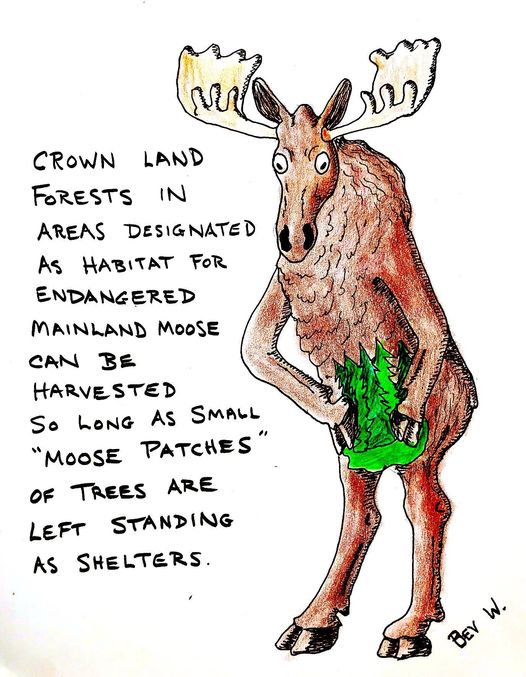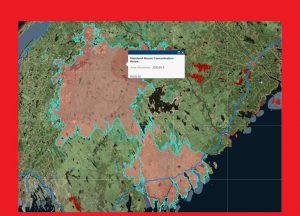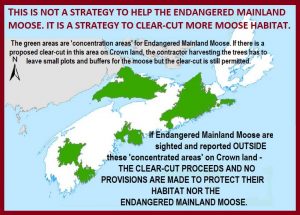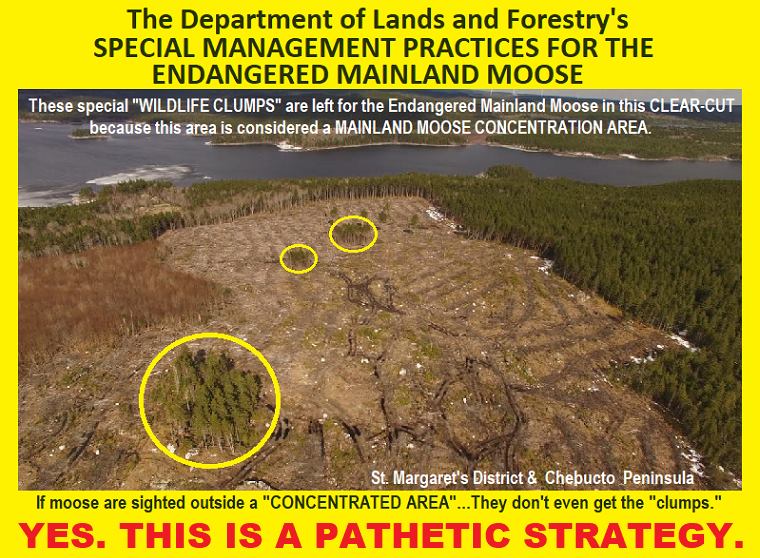
Moose Patches, Sketch by Bev Wigney, posted on Annapolis Royal & Area – Environment & Ecology (Public FB group), Mar 8, 2022
“MOOSE PATCHES: Second** in my series of sketches about Forest concerns. Did you know that harvesting of forests on Crown lands in what are referred to as “Significant Mainland Moose Concentration Areas” is permitted so long as small “Moose retention patches” are left standing? Quoting from the NS government’s “Endangered Mainland Moose Special Management Practices” document:
“Moose Retention Patches. Smaller coniferous (Forest GIS Inventory specifications: FORNON=0; >80% softwood; > 12 meter height; crown closure >60%) patches (0.1- 0.5 hectares) must also be retained within each harvest area to provide temporary shelter and concealment for moose moving within and among areas of travel or foraging habitat. These patches should be distributed so that moose will be no more than 100 m from cover at any time. Moose retention patches can be established by increasing the size of coniferous legacy tree clumps, as outlined under the Wildlife Habitat and Watercourse Protection Regulations, where those clumps meet canopy structural parameters outlined above. “
**Bev’s first one, also a classic: On Super Canopy Trees
From the Discussions:
AW: Chances are the trees fall over anyways …….
BW: That’s right — leaving patches “>12 meter height; crown closure >60%) patches (0.1- 0.5 hectares)” is just asking for blow-downs.
SMF: These are amazing sketches, so perfect for raising awareness
GF: I don’t know what there going to do in Cumberland . Deer are host to the brain worm . The other evening I drove from tatmagouche, via Wentworth to wallace and counted 1000 in the fields. I’m sure it exceeds the population we had in 82 of 9 to 12 per square km. Unless some consensus can be achieved on a massive Deer harvest, Cumberland is pointless for core habitat. If you can afford to buy the gas I invite anyone to come for a look.
DGP: Of course, the deer nos. are stimulated by the extensive clearcutting.
 SH: This is the concentrated moose area in pink. And yes – this is also where they clear-cut. Allendale near Lockeport, is an approved harvest that is 300 football fields in size. A moose was spotted in this area by a bus full of school children a couple of years ago. I asked in a Freedom of Information about moose sightings in our area and the one *I* reported was not on the list. How many others that are being reported are not showing up on ‘the list’
SH: This is the concentrated moose area in pink. And yes – this is also where they clear-cut. Allendale near Lockeport, is an approved harvest that is 300 football fields in size. A moose was spotted in this area by a bus full of school children a couple of years ago. I asked in a Freedom of Information about moose sightings in our area and the one *I* reported was not on the list. How many others that are being reported are not showing up on ‘the list’
DGP: At the same time, they eliminated the Chebucto Peninsula from Core Habitat in the final Moose Management Plan even though it has next to no clearcutting and a high percentage of protected lands. I saw moose tracks, verified by Bob Bancroft, in this area Feb 11.

GF to DGP: deer have gone through three high cycles. In the 50, mid 80 and now. Cumberland is now also the blueberry capital so I doubt if that will change . Lots green forage in the spring…the other aspect there are less hunters. You can’t discharge a rifle with in 402 m of a residence with out permission. Start drawing circles around places it’s pretty apparent unless there is a sudden culture shift it’s not going to happen. Cumberland is out of the equation far as I’m concerned.
DGP: Unfort. “wild” blueberry fields are terminal for the forest, let’s not mention the groundwater…Cumberland Co. has been ground zero for destruction of natural habitat in NS beginning with Stanfield when people were preached to about the virtues of clearcutting, told that you could then harvest t every 50 years. Responded one, “you can’t grow a 150-year old tree in 50 years” (told to me by a friend who grew up in Parrsboro area in the 50s).
GF to DGP:yes that’s true…all though I have not seen it yet , rumors are 2×4 over $10 again...
DGP to GF: I guess you might get a few out of a 50 year old tree.
I don’t know what it is about this place, been talking to carpenter lots are booking into 2023.


